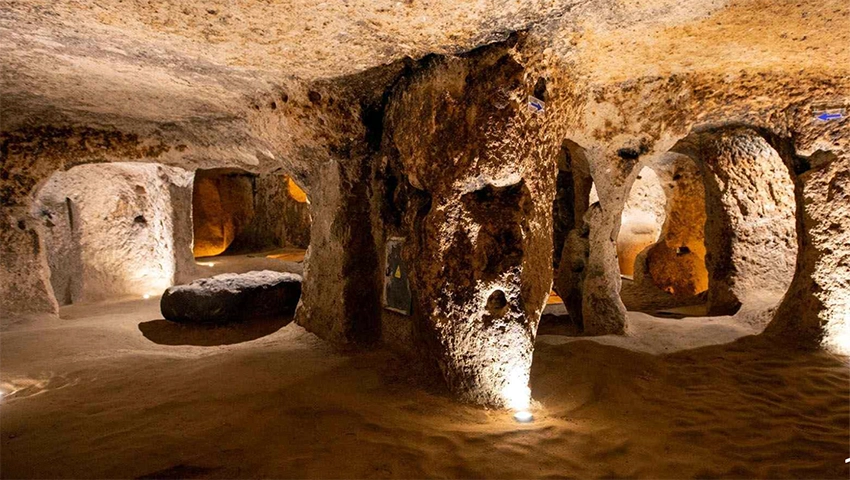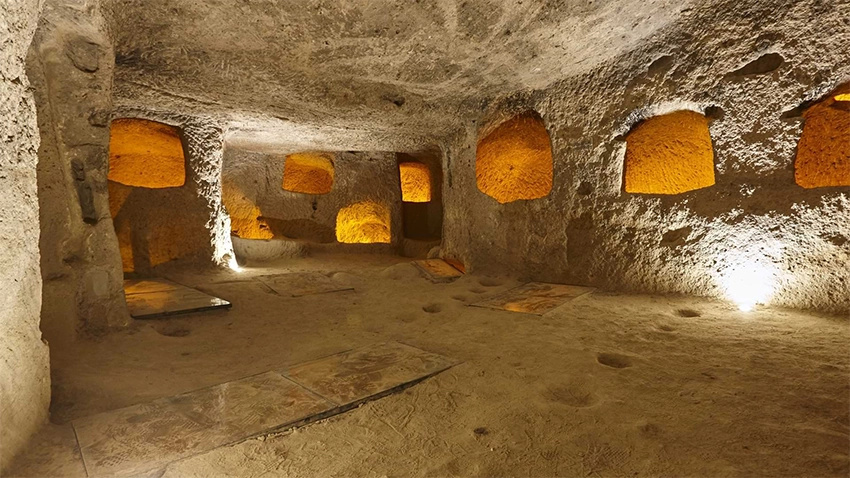Kaymakli Underground City
Kaymaklı Underground City – Cappadocia’s Horizontal Depth
History and Cultural Importance
Kaymaklı, one of Cappadocia’s largest underground cities, lies beneath the town of the same name, 20 km from Nevşehir. Its origins may date back to the 2nd millennium BC (possibly Hittites), with later expansions during Roman and Byzantine times.
During the Arab raids of the 7th–8th centuries, Christian communities used Kaymaklı as a safe refuge, just as in Derinkuyu. Unlike a temporary hideout, the city functioned as a settlement, with facilities for worship, production, and daily life.
Kaymaklı remained in occasional use during the Seljuk and Ottoman eras, especially in times of danger. In the early 20th century, local Greek Orthodox communities again took shelter here briefly. Opened to visitors in 1964, Kaymaklı is now part of the UNESCO World Heritage–listed Göreme National Park and Cappadocia Rock Sites.

Architecture and Defense Systems
The city extends across 8 levels, though only 4 are open to visitors today. Unlike the vertical layout of Derinkuyu, Kaymaklı spreads horizontally, with wider tunnels and more spacious chambers.
- Upper levels: stables, kitchens, wine presses, and storage rooms.
- Second level: a small church with two apses and burial niches.
- Lower areas: communal halls and living quarters, with strategic round stone doors at tunnel junctions.
- Ventilation shaft: nearly 80 m long, providing air and water access to all levels.
Carved niches for lamps, food storage, and tethering animals reveal details of daily life. Passages are deliberately low and narrow, designed to slow down intruders. Oral tradition even speaks of an 8–9 km tunnel linking Kaymaklı to Derinkuyu.

Visitor Information
- Location: 20 km from Nevşehir, 25 km from Göreme, 32 km from Ürgüp.
- Access: Easy by car; minibus services run from Nevşehir.
- Hours: Apr–Oct: 08:00–19:00 | Oct–Apr: 08:00–17:00. Last entry: 30–45 min before closing.
- Admission: Free with Museum Pass; ~€15 for foreign visitors (2025).
- Facilities: Parking, café, and souvenir stalls near the entrance.
Tips for Visitors
- Allow about 1 hour for your visit.
- Wear comfortable shoes; some tunnels are narrow and low-ceilinged.
- Leave large backpacks outside.
- Bring a light jacket temperature remains around 13°C year-round.
- Photography requires high ISO or long exposure; flash is discouraged.
- Guided tours enrich the experience with historical context.
Kaymaklı vs. Derinkuyu
Kaymaklı feels less claustrophobic thanks to its horizontal design, while Derinkuyu impresses with its depth and defensive engineering. If time allows, visiting both gives a fuller picture of Cappadocia’s underground world.
Nearby, you can continue to Red Valley, Soğanlı, or Mustafapaşa, combining underground history with open-air heritage.



